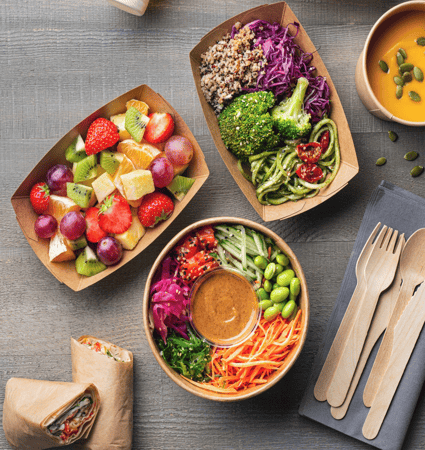The stacks of plastic and foam containers. The piles of plastic forks and knives. The wads of plastic bags.
The environmental cost of food packaging has become abundantly clear worldwide, as people rely more on takeout and delivery meals. As a result, sustainability is once again a high priority for restaurant consumers… but what does that look like when people still want their food to go?
delivery meals. As a result, sustainability is once again a high priority for restaurant consumers… but what does that look like when people still want their food to go?
The challenges of moving to sustainable takeout containers
For a glimpse of the future, look at Canada. The Canadian government recently passed a law that will prohibit the manufacture and sale of certain single-use plastics. By December 2023, restaurants will no longer be able to use plastic checkout bags; cutlery; ring carriers; stir sticks; most straws; and takeout containers made from plastics that are hard to recycle.
Restaurants are rapidly pivoting to reusable, compostable, and biodegradable takeout food containers. However, operators are encountering some significant challenges, including:
- Cost: “A bamboo fork-and-knife set costs $2 [CAN],” says Linda Nguyen of Golden Turtle in Toronto. “I do about 500 deliveries a day with Uber, so at those prices, we’re not making any money.” One cost-saving option: Eliminating to-go cutlery unless customers specifically request it.
- Sourcing: Not only are some eco-friendly containers more expensive, but they have to be purchased from specialty suppliers. This can mean delays in restocking.
- Usability: Compostable containers just don’t hold up well for soups and sauce-heavy dishes. This can present big problems for delivery orders, when drivers must contend with spilling or soaked-through containers.
- Food safety: Plastic, while problematic, has long been the go-to material for safe food handling and storage.
- Composting/recycling limitations: Many takeout containers won’t break down in home compost bins, only in high-temperature industrial composting. A common culprit is cups and containers coated with PLA (polylactic acid), a plant-based plastic.
Some items aren’t even accepted by commercial operations. Reda Wahba, co-owner of the Burger de Ville chain in Montréal, bought compostable cutlery for four years before learning that no local facility could compost them. “I bought this more expensive cutlery thinking I was doing good and it turns out I was just wasting my money,” he said.
- PFAs: Consumers are becoming alarmed about the presence of per- and polyfluoroalkyl substances (PFAS), a type of “forever chemical” that’s used in seemingly eco-friendly takeout packaging. Certain fiber trays and bowls, coated cardboard containers and paper bags all contain these chemicals, which are linked to negative health outcomes.
Strategies for success with eco-friendly takeout containers
While operators should be aware of the challenges, don’t let that deter you from adopting sustainable packaging practices. Remember: Customers want it! Sustainable, reusable, and recyclable packaging ranked first in The National Restaurant Association’s top 10 food and menu trends this year. “70% of millennials and 72% of Gen Z adults said they’d be willing to pay extra for to-go orders to cover the cost of upgraded packaging,” the NRA’s State of the Restaurant Industry Report found.
Work with your supplier to test various kinds of biodegradable containers for practicality and cost. Widely available options include takeout containers made from sugarcane, paperboard, or other plant fibers. Just be aware that many of these do contain PLA, making them unsuitable for home composting. If costs are an issue, explain the reason why to your customers.
A small step restaurants can take is switching from black-plastic or polystyrene foam containers (which can’t be recycled) to white plastic or aluminum foil, which can. Educate customers about the switch and the need to clean containers well before recycling.
The most promising approach isn’t composting or recycling takeout containers, but reusing them. Look at the fast-casual concept Just Salad, which has the longest-running reusable packaging program in the business. The MyBowl program works like this: Customers purchase their own reusable bowl for $1 and bring it back to the restaurant for eat-in meals. Every time they do so, they get an extra free topping. The chain’s pilot BringBack Program serves takeout orders in a green reusable bowl, which is then returned, sanitized and reused.
Third-party providers of reusable takeout containers are also gaining steam, although none is widely available yet. One of the pioneers is Portland-based GO Box, a subscription service that enables consumers to check out reusable containers at a variety of restaurants and return them for cleaning and reuse. GO Box recently unveiled its GO Box Zero program for restaurants, which provides co-branded containers for food and charges customers a small, refundable deposit to use them.
Here at Hamilton Beach Commercial, we support our foodservice and hospitality customers’ work to become more sustainable. We’re doing it too — using recycled material in our breakrooms, for example. Did you know that when your Hamilton Beach Commercial equipment reaches the end of its life (if it ever does) you can return it to us for recycling?


